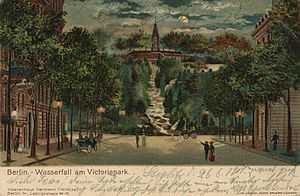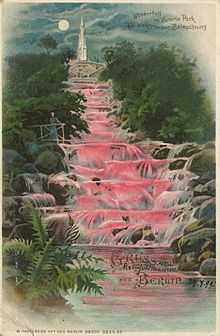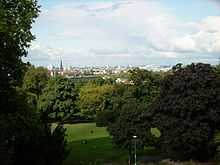Viktoriapark
The Viktoriapark (aka Victoriapark) is an urban park in the locality of Kreuzberg in Berlin, Germany. It opened in 1894.
It is situated on the Tempelhofer Berge range, forming the northern slope of the ground moraine Teltow Plateau, overlooking the glacial valley with Berlin's city centre. The major landmark of the park is a cast iron monument of 1821 dedicated by King Frederick William III of Prussia to the liberation wars (Befreiungskriege) fought at the end of the War of the Sixth coalition against France in the course of the Napoleonic Wars. It provides an excellent viewpoint over much of the central and southern portions of the city. In summer an artificial waterfall originates at the foot of the monument and continues down the hillside to the intersection of Großbeerenstraße and Kreuzbergstraße.
A historic wine-growing area, today the park is neighbouring two small vineyards, one in the northeast founded in 1968 and owned by the Senate of Berlin and cultivated by the adjacent market garden, the other one established in summer 2006 within the Victoria Quarter on the southern slope of the Kreuzberg hill.[1] However, only the old vineyard provides for the local "Kreuz-Neroberger" wine, gained from vines donated by Kreuzberg's twin towns Wiesbaden (1968) and Ingelheim am Rhein (1975), as well by the Bergstraße county (1971 and 1973) and from Bad Bergzabern (1985).[1] About 600 bottles are pressed each year.
History

As the surrounding area incorporated into Berlin in 1861 as Tempelhofer Vorstadt had become a densely built-up suburb, in 1879 Guido von Madai, president of the royal police, decreed a maximum height of buildings in the adjacent streets to uphold the visibility of the monument. The year before it had been elevated through a basement structure of 8 m (26 ft).[3] The ordinance, however, was annulled by the groundbreaking 1882 "Kreuzberg judgement" of the Prussian Royal administrative court, stating that the police had exceeded its authority to ensure public security.[4]


On 28 June 1888 the city parliament decided for Mächtig's design, who had to exchange his plans for exuberant water cascades by a more naturalistic waterfall.[7] So Mächtig and the sculptor Albert Manthe travelled through the Giant Mountains visiting natural waterfalls to get inspired.[8] Having returned Mächtig himself assisted by a confidant foreman started modelling and constructions for the park.[7] The city parliament only approved Mächtig's altered waterfall designs on 25 March 1891.[8] Using the topography of a former sand pit Mächtig designed a highland-like waterfall on the northern slope of the Kreuzberg directed in its axis towards Großbeerenstraße, named after the homonymous battle.[9] For the waterfall Mächtig used pieces of rock from the Giant Mountains and boulders.[10] Whereas some authors claim the Kreuzberg waterfall was modelled on the Zackel Falls in then Steinbach (renamed Kamieńczyk after 1945) in Lower Silesia,[8][9][11] Nungesser is doubting that.[7] Another opinion is that it was modelled on another waterfall in the Giant Mountains, the Hainfall,[citation needed] renamed after 1945 into wodospad Podgórnej. Also the Wolfsschlucht (lit. wolf's gully), designed into another exploited sand pit east of the monument, followed the homonymous example in Adersbach/Adršpach in the Giant Mountains.[12]


In the late 1890s six herms of „poets and singers of German patriotism“[15] have been raised, to wit Ernst Moritz Arndt (1899 by Hans Latt), Heinrich von Kleist (1898 by Karl Pracht), Theodor Körner (1899 by Ernst Wenck), Friedrich Rückert (1899 by Ferdinand Lepcke), Max von Schenkendorf (1899 by Alfred Reichel) and Ludwig Uhland (1899 by Max Kruse).[18] However, only three of the 3-metre tall (9.8 ft) herms (Kleist, Rückert, and Uhland) survived the Second World War.[18] Since 1989 their marble originals are preserved in the court of Leibniz High School, while aluminum replicas were posted at their original locations, with Rückert's replica meanwhile stolen.[19] In 1904 a further monument was added, located southeasterly of the lower waterfall bassin.[20] Otto Lessing had created a stele with a bust of Robert Zeller, lord mayor of Berlin between 1892 and 1898.[21] The bust got lost in the last war.[22] On the northern slope of the Kreuzberg the park also included one of Berlin's then five playgrounds for children.[23]
After in 1910 the Prussian military fiscus had sold its parade ground on Katzbachstraße to the city its Garden Director Albert Brodersen (*1857-1930*) extended the Victoria Park by 7.5 hectares (19 acres) to altogether 16 hectares (40 acres) between 1913 and 1916.[9] The extension included the layout of a playing field, the present-day Willy Kressmann Stadium, homeground of the Türkiyemspor Berlin football club. In 1925 a vivarium was opened, first hosting a roe, soon a roe family, further goats.[24] After the erection of more premises for animals between 1930 and 1931 birds, badgers, foxes, and reptiles were kept.[25] Besides these native species also two monkeys were kept.[25] All the animals - except of the birds - died in the war.[25]
The Victoria Park was included in the Nazi plans for rebuilding Berlin, but only preparations materialised. Ernst Sagebiel oriented his Tempelhof Airport building towards the monument on the Kreuzberg so that the central hall's front on the forecourt of the airport and one edge of the monument's octagonal groundplan are parallel. As seen from the monument today's Platz der Luftbrücke in front of the airport opens as a square, encircled by buildings of similar heights except for the taller central hall of the airport (mostly realised). The then planned axis consisting of a promenade and series of waterfalls cascading down the Kreuzberg hill towards the square was never realised, the interjacent block of houses remained untouched.[26]

Since 1949 the annual late summer funfayre Kreuzberger Festliche Tage (Kreuzberg festive days, founded as Kreuzberg-Festwoche, i.e. Kreuzberg festival week) is held in the park, accompanied by more events also in other locations.[31] In August 1952 Kreuzberg's borough mayor Willy Kressmann (SPD) inaugurated a 8-metre tall (26 ft) cross of pine wood with a crown of thorns of barbed wire on the upper edge of the sodded northwestern slope as Memorial for the eastern German Homeland (Mahnmal für die ostdeutsche Heimat), commemorating the death of 100,000s killed in atrocities, by forced labour or other maltreatment, and the fate of the surviving 12 million refugees and expellees from former eastern Germany and neighbouring foreign countries ruled by pro-Soviet governments.[32] In August 1953 a memorial stone was added in honour of the victims of the communist suppression of the Uprising of 1953 in East Germany.[33] The vivaria were restocked in the same year.[25] In November 1958 the smashed southern edge of the socket octagon was reconstructed again.[34]
References

- Baedekers Berlin-Kreuzberg: Bezirksführer (11977), Ostfildern/Kemnat and Munich: Baedeker, 21988, ISBN 3-87954-091-8.
- Kathrin Chod, Herbert Schwenk and Hainer Weißpflug, Berliner Bezirkslexikon: Friedrichshain-Kreuzberg, Berlin: Haude & Spener / Edition Luisenstadt, 2003, ISBN 3-7759-0474-3.
- Denk mal Kreuzberg! Ein Architekturführer der kommunalen Baudenkmale im Bezirk Kreuzberg, Bezirksamt Kreuzberg von Berlin / Hochbauamt and Untere Denkmalschutzbehörde (eds.), Berlin: no publ., 1998, no ISBN.
- Rike Fischer, Auf dem Gipfel von Berlin – Ein Spaziergang durch den Viktoriapark in Kreuzberg, Verein zur Erforschung und Darstellung der Geschichte Kreuzbergs and Bezirksmuseum Friedrichshain-Kreuzberg (eds.), Berlin: Kreuzberg-Museum, 2007, ISBN 3-935810-07-5.
- Ilse Nicolas, Kreuzberger Impressionen (11969), Berlin: Haude & Spener, 21979, (=Berlinische Reminiszenzen; vol. 26), ISBN 3-7759-0205-8.
- Michael Nungesser, Das Denkmal auf dem Kreuzberg von Karl Friedrich Schinkel, ed. on behalf of the Bezirksamt Kreuzberg von Berlin as catalogue of the exhibition „Das Denkmal auf dem Kreuzberg von Karl Friedrich Schinkel“ in the Kunstamt Kreuzberg / Künstlerhaus Bethanien Berlin, between 25 April and 7 June 1987, Berlin: Arenhövel, 1987, ISBN 3-922912-19-2.
- Klaus-Dieter Wille, Spaziergänge in Kreuzberg, Berlin: Haude & Spener, 1986, (=Berliner Kaleidoskop: Schriften zur Berliner Kunst- und Kulturgeschichte; vol. 32), ISBN 3-7759-0287-2.
Notes
- ↑ 1.0 1.1 Rike Fischer, Auf dem Gipfel von Berlin – Ein Spaziergang durch den Viktoriapark in Kreuzberg, see references for bibliographical details, pp. 57seq. ISBN 3-935810-07-5.
- ↑ Michael Nungesser, Das Denkmal auf dem Kreuzberg von Karl Friedrich Schinkel, see references for bibliographical details, p. 38. ISBN 3-922912-19-2.
- ↑ Baedekers Berlin-Kreuzberg: Bezirksführer, see references for bibliographical details, p. 35. ISBN 3-87954-091-8.
- ↑ Cf. details on the suit "M. vs royal police department in Berlin", in: Entscheidungen des Königlichen Oberverwaltungsgerichts: 106 vols., Berlin: Heymann, 1877–1941, vol. 9 (2nd ed., 1887), Ludwig Jacobi, Wilhelm Jebens and Gottlieb von Meyeren (eds.), pp. 345seqq.
- ↑ Klaus-Dieter Wille, Spaziergänge in Kreuzberg, see references for bibliographical details, p. 22. ISBN 3-7759-0287-2.
- ↑ Michael Nungesser, Das Denkmal auf dem Kreuzberg von Karl Friedrich Schinkel, see references for bibliographical details, p. 86. ISBN 3-922912-19-2.
- ↑ 7.0 7.1 7.2 7.3 7.4 7.5 7.6 Michael Nungesser, Das Denkmal auf dem Kreuzberg von Karl Friedrich Schinkel, see references for bibliographical details, p. 87. ISBN 3-922912-19-2.
- ↑ 8.0 8.1 8.2 8.3 Rike Fischer, Auf dem Gipfel von Berlin – Ein Spaziergang durch den Viktoriapark in Kreuzberg, see references for bibliographical details, p. 54. ISBN 3-935810-07-5.
- ↑ 9.0 9.1 9.2 Baedekers Berlin-Kreuzberg: Bezirksführer, see references for bibliographical details, p. 34. ISBN 3-87954-091-8.
- ↑ Ilse Nicolas, Kreuzberger Impressionen, see references for bibliographical details, p. 14. ISBN 3-7759-0205-8.
- ↑ Kathrin Chod, Herbert Schwenk and Hainer Weißpflug, Berliner Bezirkslexikon: Friedrichshain-Kreuzberg, see references for bibliographical details, p. 390. ISBN 3-7759-0474-3.
- ↑ Rike Fischer, Auf dem Gipfel von Berlin – Ein Spaziergang durch den Viktoriapark in Kreuzberg, see references for bibliographical details, p. 74. ISBN 3-935810-07-5.
- ↑ Kathrin Chod, Herbert Schwenk and Hainer Weißpflug, Berliner Bezirkslexikon: Friedrichshain-Kreuzberg, see references for bibliographical details, p. 383. ISBN 3-7759-0474-3.
- ↑ Rike Fischer, Auf dem Gipfel von Berlin – Ein Spaziergang durch den Viktoriapark in Kreuzberg, see references for bibliographical details, p. 55. ISBN 3-935810-07-5.
- ↑ 15.0 15.1 Klaus-Dieter Wille, Spaziergänge in Kreuzberg, see references for bibliographical details, p. 23. ISBN 3-7759-0287-2.
- ↑ Rike Fischer, Auf dem Gipfel von Berlin – Ein Spaziergang durch den Viktoriapark in Kreuzberg, see references for bibliographical details, pp. 54seq. ISBN 3-935810-07-5.
- ↑ Michael Nungesser, Das Denkmal auf dem Kreuzberg von Karl Friedrich Schinkel, see references for bibliographical details, p. 88. ISBN 3-922912-19-2.
- ↑ 18.0 18.1 Michael Nungesser, Das Denkmal auf dem Kreuzberg von Karl Friedrich Schinkel, see references for bibliographical details, p. 92. ISBN 3-922912-19-2.
- ↑ Rike Fischer, Auf dem Gipfel von Berlin – Ein Spaziergang durch den Viktoriapark in Kreuzberg, see references for bibliographical details, p. 40. ISBN 3-935810-07-5.
- ↑ Stadt_Raum Kreuzberg: Kunst- und Sonderobjekte im städtischen Raum, Bezirksamt Kreuzberg von Berlin / Hochbauamt and Untere Denkmalschutzbehörde (eds.), Berlin: no publ., 2000, p. 10. No ISBN.
- ↑ Michael Nungesser, Das Denkmal auf dem Kreuzberg von Karl Friedrich Schinkel, see references for bibliographical details, p. 82. ISBN 3-922912-19-2.
- ↑ Rike Fischer, Auf dem Gipfel von Berlin – Ein Spaziergang durch den Viktoriapark in Kreuzberg, see references for bibliographical details, p. 67. ISBN 3-935810-07-5.
- ↑ Karl Baedeker, Berlin und Umgebungen: Handbuch für Reisende, Leipzig: Baedeker, 71891, p. 126. No ISBN.
- ↑ Rike Fischer, Auf dem Gipfel von Berlin – Ein Spaziergang durch den Viktoriapark in Kreuzberg, see references for bibliographical details, p. 70. ISBN 3-935810-07-5.
- ↑ 25.0 25.1 25.2 25.3 Rike Fischer, Auf dem Gipfel von Berlin – Ein Spaziergang durch den Viktoriapark in Kreuzberg, see references for bibliographical details, p. 71. ISBN 3-935810-07-5.
- ↑ See Christine Heeb, "A multifaceted monument - the complex heritage of Tempelhof Central Airport", Master of Arts thesis in World Heritage Studies, Brandenburg University of Technology Cottbus, 2007 (pdf), pp. 23-24.
- ↑ Michael Nungesser, Das Denkmal auf dem Kreuzberg von Karl Friedrich Schinkel, see references for bibliographical details, p. 94. ISBN 3-922912-19-2.
- ↑ Dietmar Arnold and Reiner Janick, Sirenen und gepackte Koffer: Bunkeralltag in Berlin, Berlin: Links, 2003, p. 100. ISBN 3-86153-308-1.
- ↑ The casts were taken in 1942, survived the cracking of the socket building rather intact, so that the original Quadriga almost completely destroyed in the Second World War could be replaced by a replica cast in West Berlin in 1957. Cf. Rike Fischer, Auf dem Gipfel von Berlin – Ein Spaziergang durch den Viktoriapark in Kreuzberg, see references for bibliographical details, p. 28. ISBN 3-935810-07-5.
- ↑ Rike Fischer, Auf dem Gipfel von Berlin – Ein Spaziergang durch den Viktoriapark in Kreuzberg, see references for bibliographical details, p. 29. ISBN 3-935810-07-5.
- ↑ Berlin-Bibliographie: 11 vols. (1965-1999), vol. 1: '1961 bis 1966', Berlin, de Gruyter, 1965, (=Veröffentlichungen der Historischen Kommission zu Berlin; vol. 15), p. 782. No ISBN.
- ↑ Rike Fischer, Auf dem Gipfel von Berlin – Ein Spaziergang durch den Viktoriapark in Kreuzberg, see references for bibliographical details, p. 64. ISBN 3-935810-07-5.
- ↑ Rike Fischer, Auf dem Gipfel von Berlin – Ein Spaziergang durch den Viktoriapark in Kreuzberg, see references for bibliographical details, p. 65. ISBN 3-935810-07-5.
- ↑ Michael Nungesser, Das Denkmal auf dem Kreuzberg von Karl Friedrich Schinkel, see references for bibliographical details, p. 95. ISBN 3-922912-19-2.
| Wikimedia Commons has media related to Viktoriapark. |
| ||||||||
Coordinates: 52°29′20″N 13°22′50″E / 52.48889°N 13.38056°E
